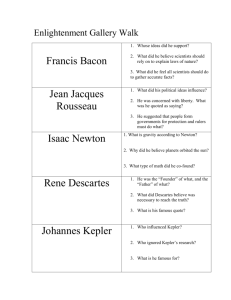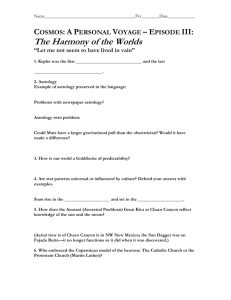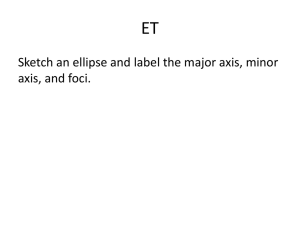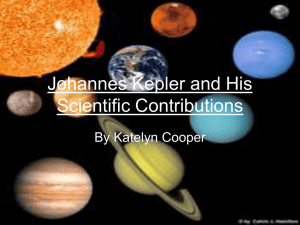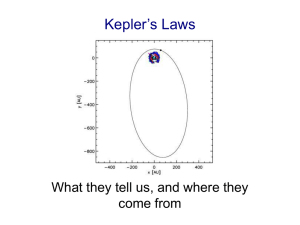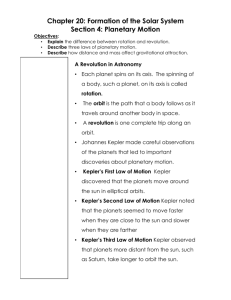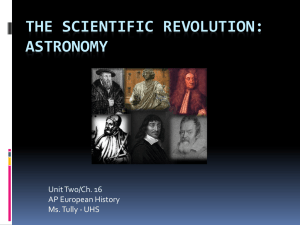Sample full sentence outline (Marsha Mayberry on Johannes Kepler)
advertisement
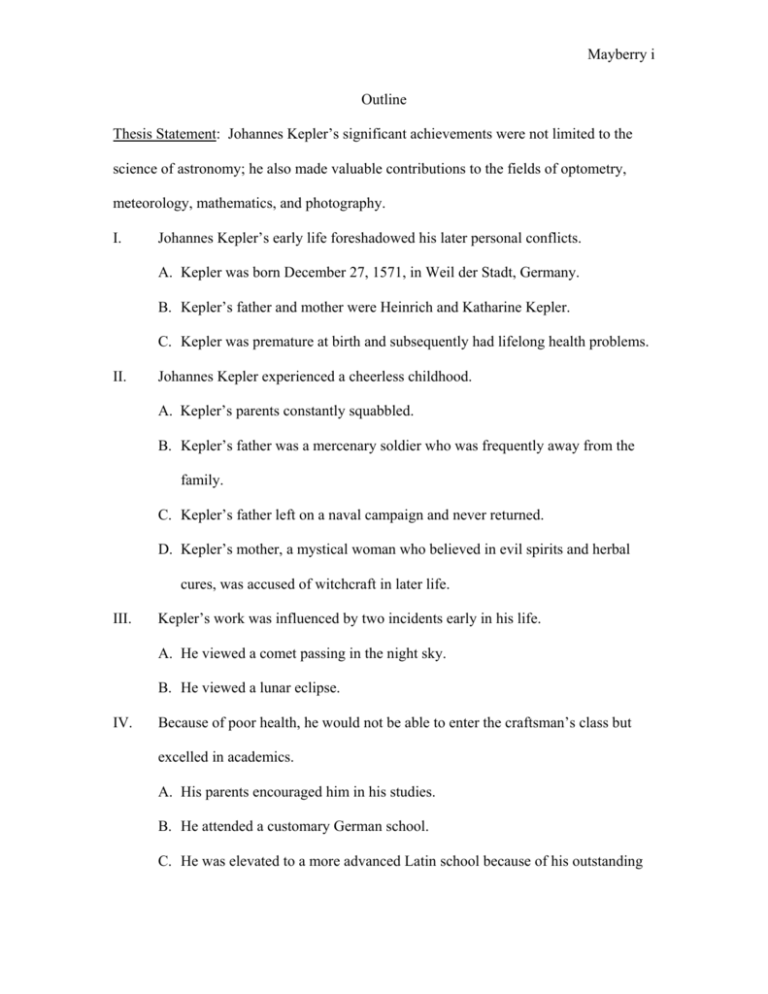
Mayberry i Outline Thesis Statement: Johannes Kepler’s significant achievements were not limited to the science of astronomy; he also made valuable contributions to the fields of optometry, meteorology, mathematics, and photography. I. Johannes Kepler’s early life foreshadowed his later personal conflicts. A. Kepler was born December 27, 1571, in Weil der Stadt, Germany. B. Kepler’s father and mother were Heinrich and Katharine Kepler. C. Kepler was premature at birth and subsequently had lifelong health problems. II. Johannes Kepler experienced a cheerless childhood. A. Kepler’s parents constantly squabbled. B. Kepler’s father was a mercenary soldier who was frequently away from the family. C. Kepler’s father left on a naval campaign and never returned. D. Kepler’s mother, a mystical woman who believed in evil spirits and herbal cures, was accused of witchcraft in later life. III. Kepler’s work was influenced by two incidents early in his life. A. He viewed a comet passing in the night sky. B. He viewed a lunar eclipse. IV. Because of poor health, he would not be able to enter the craftsman’s class but excelled in academics. A. His parents encouraged him in his studies. B. He attended a customary German school. C. He was elevated to a more advanced Latin school because of his outstanding Mayberry ii performance. D. Kepler’s studies were always influenced by his devotion to his Lutheran religion. E. He attended the convent school at Adelberg but was soon elevated to a higher school in Maulbronn. F. Kepler passed the entrance exams at Tübingen University, where he studied mathematics, physics, and astronomy. V. At Tübingen University, Kepler met Michael Maestlin, who introduced him to the Copernican Theory. A. The Church strictly opposed the Copernican Theory. B. Kepler’s introduction to the Copernican Theory was the beginning of his work in astronomy. VI. Kepler moved to Graz, Austria, and accepted an appointment as mathematics teacher at a Protestant seminary. A. Kepler’s job at Graz also included serving as district mathematician for the noblemen of Graz. B. He made calendars and predicted the future. C. Income from his job allowed him to explore his deeper interests in theology and the Copernican Theory. VII. Kepler believed that all scientific relationships could be expressed mathematically. A. He was influenced by the work of other great mathematically-oriented scientists such as Hipparchus, Plato, St. Augustine, Nicholas of Cusa, and Mayberry iii Pythagoras. B. Kepler’s evaluation of the Copernican Theory revolved around the placement of geometric figures within each other. VIII. Kepler published his book Mysterium Cosmographicum that detailed his work with the planetary orbits and defended the Copernican Theory. A. The publication of his book brought him an offer from Tycho Brahe to move to Prague and continue his research. B. He moved to Prague to escape religious persecution in his home of Graz. IX. During his years with Brahe, Kepler worked on the theory of the motion of Mars. A. He discovered the first two laws of planetary motion. B. The first two laws of planetary motion were published in his book Astronomia Nova. X. Kepler published two more books, Astronomia pars optica, for which he earned the title of founder of modern optics, and Dioptrice. A. Kepler was the first person to explain the formation of pictures with pinhole cameras, the process of vision by refraction, the formulation of eyeglasses, and the use of both eyes for depth perception. B. His book Dioptrice was the first to describe images and magnification, the principles of how a telescope works, and the first to explore the properties of internal reflection. XI. Beginning in 1611, Kepler’s life changed dramatically. A. His wife and two children died of disease during the disorders of the Counter- Mayberry iv Reformation. B. The Lutherans were forced out of Prague and Kepler moved to Linz, Austria, where he prepared three more major works, Harmonice Mundi, Stereometria Doliorum Vinarioum, and Epitome Astronomiae Copernicanae. C. His mother was accused of witchcraft and he traveled to Württemberg to defend her against the charges. XII. In 1618, Kepler discovered the third law of planetary motion. A. The third law of planetary motion was published in his book Harmonice Mundi. B. The third law influenced Isaac Newton’s law of gravitation. XIII. Because of financial hardship, Kepler moved to Regensburg in 1626. A. He published his last works, Emphremerides pars II, Emphremerides pars III, and Somnium seu astronomia lunari. B. Johannes Kepler died in 1630.

